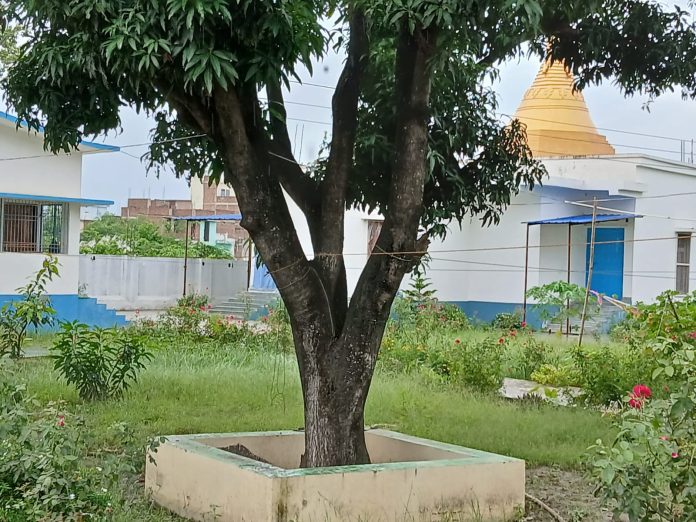Dissatisfaction, depression, anxiety and persistent insecurities in life are more burdensome now than they were some two and half thousand years ago. Dissatisfactions and depression arise from too much pondering over the past, while uncertainties of the future make one anxious. A stress-free life is possible if we can pay attention to the present because the magic of life is in “this” moment only. Buddha developed Vipasyana (means seeing in a special way), a meditation technique that enhances one’s ability to intentionally pay attention to the present moment non-judgmentally in a non-partisan way as a witness. The regular practice of Vipasyana rewires our brain in a new way. This not only reduce depression and anxieties but also enhances ability to remain focussed that has strong bearing on our performance as well. One can learn this method in Champaran, the land where Lord Buddha and Ashoka the Great once walked. Vipasyana Centre in Chakia offers a 10-days residential course free of cost (the centre runs entirely on donation). Before or after attending the course, one can make pilgrimage to the four nearby places of Kesariya, Lauriya Areraj, Lauriya Nandangarh and Rampurva in Champaran which are very closely associated with the life of Lord Buddha to pay homage and to see and feel the tangible Pillars and Stupas that Ashoka the Great installed there for reverence by the posterity.
Lord Buddha discovered the way to be happy and blissful in the world filled with sorrow. He employed causal analysis to diagnose and arrive at a solution for the pervasive suffering manifested mainly as mental agonies in the form of disappointments, insecurities of life, depression and anxieties triggered by the changes taking place in one’s life course including ageing, poor health conditions and loss of loved ones etc. He found that life is actually blissful. There is joy everywhere. But the joy is in transitoriness; the bliss could be found in the fleeting moment through the practice of meditation. The recognition and appreciation of the ‘temporariness’ of everything in life is the starting point followed by the cognition or the conscious awareness of the causative factors behind mental sufferings and the cultivation of mind to come to terms with the realities of thoughts and desires. Conscious awareness of the factors causing mental suffering and cultivating mind for mindfulness (i.e., awareness of the moment) are keys to freedom from pervasive suffering. One must always be aware of the moment we are in because beauty of life is this moment only.
Vipasyana (meaning seeing in a special way) is the meditation technique developed by Lord Buddha to enhance one’s ability to intentionally pay attention to the present moment non-judgmentally in a nonpartisan way as a witness.
The first step is Ana pana,” (or “Anapana” or “Anapanasati”) which refers to observing the natural, normal breath as it enters and exits the nostrils. It increases self-awareness. The first three days of the 10 days course are spent practicing this. Unlike in pranayam where breath is controlled, Ana pana is about being aware of breaths. The next seven days are used in systematically observing sensations in different parts of the body in a non-partisan way without affect under the guidance of the teacher.
The process involves enhancing two skills – “the ability to intentionally remain focused in the present moment” and “the ability to remain a non-partisan witness of the sensations”.
Dissatisfactions and depression arise from too much pondering over the past incidents, while uncertainty of the future makes one anxious of the outcome in future. Therefore, it is imperative to pay attention to the present moment so as to avoid persistent insecurities of life because the magic of life is in “this” moment only. We can effectively reduce both depression and anxiety by honing this skill and lead a blissful life.
Human brain displays remarkable plasticity. Life experiences, new attitudes and trainings make changes in the brain and form new wirings. For example, changing mindsets (i.e. attitudes that determine how one respond to a situation in certain way) changes brain. Similarly, compassion training is known to increase activations in a non-overlapping brain network across ventral striatum, pregenual anterior cingulate cortex and medial orbitofrontal cortex.
The regular practice of observing one’s own bodily sensations in a non-participant way merely as a witness (and not as a feeler or enjoyer of the sensations) rewires our brain in a new way. This not only reduce depression and anxieties but also enhances ability to remain focussed that has strong bearing on performance. Some monks practicing Vipasyana go much beyond and develop ability to tolerate extreme pain and adverse conditions. Some Tibbetan Buddhist monks can meditate for long hours sitting in sub-zero temperatures. An extreme example of pain tolerance through deep meditation was the unfortunate 1963 case of the self-immolating Vietanamese Buddhist monk Thích Quảng Đức who remained composed and unaffected sitting in the meditation pose for full three and half minutes before falling aside.
And there are other interesting benefits of Vipasyana course as well. If you are trying to lose weight for controlling hypertension and diabetes, the Vipasyana course may be helpful because you eat your breakfast at 6.30 am and lunch-cum-dinner at 11.00 am in the morning. And that’s it! You remain on an 18-hour intermittent fasting schedule for 10 days, although the first timers are given some snacks to eat before sunset at 5.00 in the afternoon. Further, during these 10 days, you are on “Arya maun”, meaning you do not communicate with anyone directly or indirectly. You are not allowed any communication device either. So, no ringing mobiles or messages to reply or social media reels or web browsing. And of course, no intoxicants in any form. All these mean you kind of reboot yourself after the nearly 12 hours of vipasyana meditation per day for 10 days.
All these you do in Champaran, the land where Lord Buddha and Ashoka the Great once walked. The four main pilgrimage sites of Kesariya, Lauriya Areraj, Lauruya Nandangarh and Rampurva in Champaran are closely associated with Lord Buddha and Emperor Ashoka. Emperor Ashoka commemorated these sites with Pillars and Stupas which exist today and can be visited.
Situated at a distance of 25 km from the Vipasyana Centre in Chakia is the legendary site of Kesariya (or Kesaria or Kesaputta) where Lord Buddha had delivered Kessaputtiya Sutta or ‘Kalama Sutta’ in which He advised people to rely on their own experience and exerted them to adopt and apply the (scientific) approach of ‘’ observation, analysis and reasoning’’ instead of blind belief and faith. Emperor Ashok commemorated the site by building a stupa which still exists. (Read more about Kesariya)
At about 55 km from Chakia is Lauriya Areraj which is associated with early ascetic phase of Lord Buddha’s life at Alara Kalama’s hermitage. Ashoka commemorated this site with a Dhamma Stambh (Askoa Pillar) which bears six of his edicts. The capital is missing but the pillar exists. It is said that the pillar originally had Garuda capital. (Read more about Lauriya Areraj)
The famous Lauriya Nandangarh site in West Champaran is about 105 km from the Vipasyana Centre in Chakia. Emperor Ashoka commemorated this site with a Dhamma Stambh adorned with a single Lion Capital at the top. The pillar bears six pillar edicts in Brahmi. About 2 KM south-west of the pillar, there are Stupas (15 stupa mounds in the three rows). (Read more about Lauriya Nandangarh)
Rampurva is about 135 km in West Champaran from the Vipasyana Centre in Chakia. This place is uniquely significant because this is only place where Emperor Ashok chose to construct two Dhamma Stambha (twin Ashokan Pillars). The Ashokan pillars at this site are believed to commemorate Buddha’s renunciation. This is where at the bank of river Anoma (now called Harbora) Siddhartha exchanged his royal robes for an ascetic’s dress and chopped off his elegant hair locks and embarked on the path of search of knowledge in the forests of Champaran. There are indications that Rampurva could well be the actual site of Kushinara where Lord Buddha attained parinirvana and was cremated which seems to corroborate why Emperor Ashoka held this site to be uniquely significant. It is suggested that Ashoka had commemorated the spot of parinivana with a pillar. Another pillar, 300 paces apart marked the place of the Buddha’s cremation”. (Read more about Rampurva)
Towards the end of his life, Buddha passed through these places in Champaran for the last time from Vaishali towards Kushinara in north, the place of his parinirvana.
After Vipasyana Shivir in Chakia one can visit these nearby four places in Champaran to pay homage to Lord Buddha and to touch and feel the tangible Pillars and Stupas that Ashoka the Great installed there for reverence by the posterity.
***
Comments
Likhit Bharadwaj (18 November 2025)
I absolutely loved the fact that you brought in bits of external information such as the physiological effects of Vipassana on specific parts of the brain and quoting the examples of historic monks and their interactions with meditation. Ending with the tourism side of the location is something I didn’t see coming but it was a pleasant surprise.
***
| Address | Dhamma Upavana Chakia Vipasyna Centre, Hospital Road, Near Old SRAP College, Bara Chakia – 845 412 District – East Champaran, Bihar (India) |
| Phone | |
| info@upavana.dhamma.org | |
| Website | https://upavana.dhamma.org/en/ |
| Course Schedule & apply | https://www.dhamma.org/en/schedules/schupavana |
| Google locator | https://maps.app.goo.gl/xqMcc8CaAHNBoyWj6 |
Google map
***


